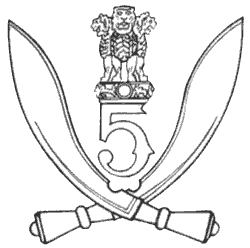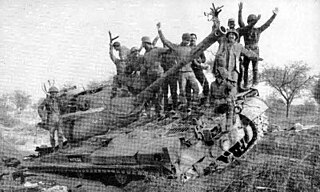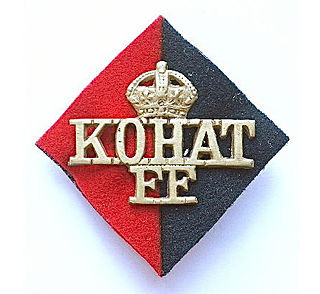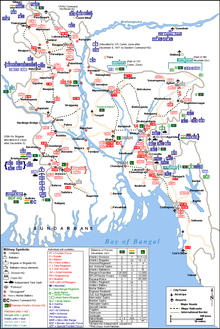
The North-West Frontier was a region of the British Indian Empire. It remains the western frontier of present-day Pakistan, extending from the Pamir Knot in the north to the Koh-i-Malik Siah in the west, and separating the modern Pakistani frontier regions of North-West Frontier Province, Federally Administered Tribal Areas and Balochistan from neighbouring Afghanistan in the west. The borderline between is officially known as the Durand Line and divides Pashtun inhabitants of these provinces from Pashtuns in eastern Afghanistan.

5th Gorkha Rifles, also abbreviated as 5 GR(FF) is an infantry regiment of the Indian Army comprising Gurkha soldiers of Nepalese origin. It was formed in 1858 as part of the British Indian Army. The regiment's battalions served in the First World War (Mesopotamia) and Second World War.

The Battle of Basantar, also known as the Battle of Shakargarh or Battle of Barapind, was one of the vital battles fought as part of the Indo-Pakistani War of 1971 in the western sector of India. The Indian troops won a hard-fought battle that secured this area in the Punjab/Jammu sector. The name Battle of Basantar actually encompasses the entire gamut of battles and skirmishes fought in the Shakargarh sector.
The 15th Indian Division was an infantry division of the British Indian Army that saw active service in the First World War. It served in the Mesopotamian Campaign on the Euphrates Front throughout its existence. It did not serve in the Second World War, but was reformed at Dehradun in 1964 as part of the post-independence Indian Army.

The Regiment of Artillery is a combat/fighting arm of the Indian Army, which provides massive firepower during all ground operations of the Indian Army. It is a successor to the Royal Indian Artillery (RIA) of British Indian Army, which itself traces its origins to the formation of Bombay Artillery in 1827.
On 25 March 1971, the Pakistani military, supported by paramilitary units, launched the military operation to pacify the insurgent-held areas of East Pakistan, which led to a prolonged conflict with the Bengali Mukti Bahini. Although conventional in nature during March–May 1971, it soon turned into a guerrilla insurgency from June of that year. Indian Army had not directly supported the Bengali resistance but had launched Operation Jackpot to support the insurgency from May 1971.

The 21st Kohat Mountain Battery (Frontier Force) was an artillery unit of the British Indian Army. It was raised in 1851 as the No. 2 Horse or Punjab Light Field Battery, Punjab Irregular Force. It became the 21st Kohat Mountain Battery (Frontier Force) in 1903. In 1947, it was transferred to the Pakistan Army, where it exists as the 2nd Royal Kohat Battery (Frontier Force) of The First (SP) Medium Regiment Artillery (Frontier Force).
The 23rd Peshawar Mountain Battery (Frontier Force) was an artillery unit of the British Indian Army. It was raised in 1853 as the Peshawar Mountain Train. It became the 23rd Peshawar Mountain Battery (Frontier Force) in 1903. In 1947, it was transferred to the Pakistan Army, where it exists as the 3rd Peshawar Battery (Frontier Force) of The First (SP) Medium Regiment Artillery (Frontier Force).
The 24th Hazara Mountain Battery (Frontier Force) was an artillery battery of the British Indian Army.
1821 Light Regiment is part of the Regiment of Artillery of the Indian Army.
22 Medium Regiment (Sittang and Yenangyaung) is part of the Regiment of Artillery of the Indian Army. It was raised in 1920 as 8 Pack Artillery Brigade.
23 Field Regiment is part of the Regiment of Artillery of the Indian Army.
1851 Light Regiment is part of the Regiment of Artillery of the Indian Army.
15 Medium Regiment is part of the Regiment of Artillery of the Indian Army.
52 Medium Regiment (Sanjoi Mirpur) is part of the Regiment of Artillery of the Indian Army.
97 Field Regiment is part of the Regiment of Artillery of the Indian Army.
90 Field Regiment is part of the Regiment of Artillery of the Indian Army.
175 Medium Regiment is part of the Regiment of Artillery of the Indian Army.
81 Medium Regiment is part of the Regiment of Artillery of the Indian Army.
51 Medium Regiment is part of the Regiment of Artillery of the Indian Army.






